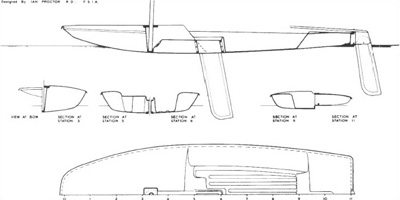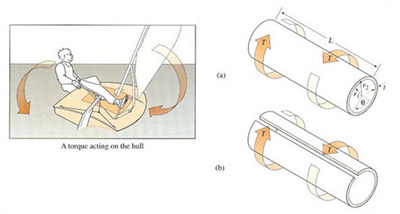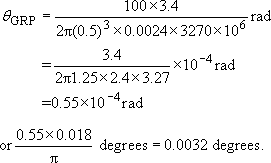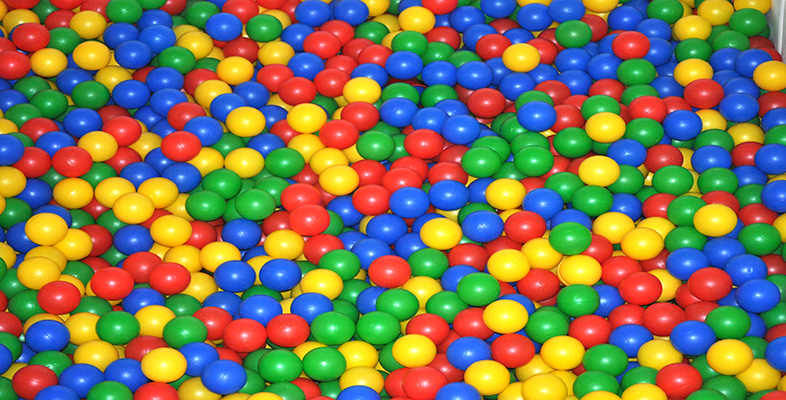6.4.1 Materials selection
Among the common thermoplastics available in the mid-1970s, polypropylene appeared as a front runner on grounds of toughness, density and cost Table 9). However, it is subject to creep (being uncrosslinked) and possesses a low tensile modulus of ca. 1500 MN m−2. Its merit index is 12.7 due to the low density of 0.9 Mg m−3, making it comparable to GRP. If it replaced GRP, here would be a weight penalty of 3.6/12.7 = 1.07 or about 7 per cent. On the other hand, the hull would have to be considerably thicker:

the original boat the GRP hull was 2.4 mm thick, so that the polypropylene boat needed to be 2.4 × 1.78 or 4.3 mm thick to give the same flexural stiffness. The assembled hull (Figure 62) possessed considerable intrinsic stiffness owing to the monocoque construction, with the deck and hull joined at the gunwale.

Self assessment question 11
Assess the importance of polymer choice on the torsional rigidity of the monocoque hull structure of the Topper using the equation for the angle of twisting, θ (radians), produced by a torque T (in N m) on a hollow cylinder of thickness t, radius r and length L.


G is the shear modulus and may be taken as E/2.6 for both GRP and polypropylene. Use Figure 62 for approximate dimensions and calculate the angular distortion created by a maximum torque of 100 N m. (Figure 63)
Answer
The comparative effect of replacing a GRP hull by a polypropylene hull of the same dimensions except thickness can be simply calculated from the torsion equation:

Inserting the known values of modulus and thickness,

In other words, the thicker polypropylene hull will distort over three times as much as the GRP hull despite the fact that their flexural stiffnesses are very similar.
An absolute value for angular distortion can be estimated very roughly by assuming r = 0.5 m and L = 3.4 m (Figure 62):

so θGRP=0.0032 degrees or 0.19 minutes, and θpp ≈ 0.6 minutes.
A moment of 100 N m is equivalent to a 50 kg individual exerting a lever 20 cm from the centre of gravity of the craft – not an untypical sailing moment. Such distortion would be detectable on a small craft but would not be serious enough to affect sailing characteristics to any great extent.
| Polymer grade | Melt flow index at 190 °C (10 kg load) | Flexural modulus/ MNm−2 | Toughness (Izod impact) at 23 °C/J m−1 | Softening temperature/ °C |
|---|---|---|---|---|
| GW522M | 22 | 1800 | 45 | 148 |
| GX543M | 60 | 1800 | 40 | 148 |
| GY545M | 120 | 1800 | 40 | 148 |
| GY621M(copolymer) | 100 | 1410 | 80 | 147 |
| GY703M (copolymer) | 11 | 1000 | 500 | 143 |
| GY702M (copolymer) | 60 | 1100 | 100 | 145 |
The design team at Rolinx evaluated the torsional stiffness of the new Topper by covering the forward part of the deck with a grid of lines to give a visual check on distortion during sailing. The distortion was certainly visible, but did not apparently affect sailing characteristics too seriously.
Similarly, the problem of creep was thought not to be important, partly because of the intermittent nature of sailing stresses, both in terms of magnitude and direction, and partly because of the short-term expected loadings. Small sail boats are used perhaps a few hours a day before disassembly and storage. Creep, and distortion resulting from creep, increase with time and severity of loading.
The main grades of Propathane polypropylene available to the moulders are shown in Table12; they encompass both homo- and copolymer grades of varying MFI, flexural modulus, impact strength and softening points. The impact strength in the Izod test is measured on a standard centrally notched bar of material, which is struck with a falling pendulum. The impact strength is simply the energy absorbed per metre of notch when the specimen breaks in a brittle fashion. The variation in impact strength at ambient temperature is much greater than the variation in modulus, and it was this parameter which assumed greater importance as the project developed. Sailing hulls, particularly those for small, hand launched boats, suffer a considerable number of impacts in service and it could prove catastrophic if a brittle crack were to propagate through the hull!
The upper softening point – the temperature when the polymer starts to deform, which is some distance below the true melting point – was not an important design parameter. The greatest temperatures to which the boat could possibly be exposed did not exceed 70 °C (hull surface temperature in bright sunshine in Middle Eastern climates), well below possible softening points. The lower limit was felt to be important however; the hull could be exposed to sub-zero temperatures when sailed in freezing sea water. The copolymer grades possessed much greater strength below 0 °C owing to the depressant effect of the ethylene component on the glass transition temperature.
Despite the greater flexibility of the toughest grade (GY703M), it represented the best choice on the grounds of toughness over a wide temperature range. However, the constraints of manufacture meant that a compromise with a lower molecular mass grade was necessary.
